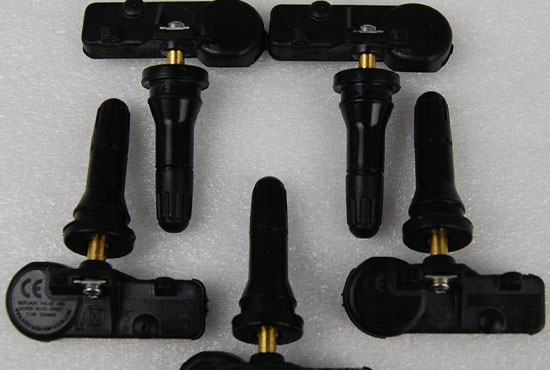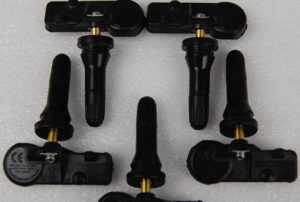TPMS sensors have effectively made driving less complicated. These sensors detect when a tire is losing pressure so they help prevent flats while you are driving. The sensors have almost eliminated people being stranded in the middle of nowhere with a flat tire.
The majority of the time the TPMS sensor malfunction is caused by a low or dying battery.
Jeep Wrangler TPMS Sensor

The tire pressure monitoring sensors started to be installed on Jeep Wranglers in 2007. The sensors were introduced in the 2008 models that were manufactured that year.
Tires have specific amounts of pressure they should maintain. The Jeep Wrangler tires should have a cold pressure [the pressure before driving heats up the tires] of about 35 PSI. If you are uncertain what your tire pressure should be look at the sticker on the inside of the driver’s door for this information.
Saves You from Problems and Costly Repairs
A TPMS sensor does not just reduce the chances that you will be stranded on a dark deserted highway with a flat tire. They also help to prevent tire blowouts from low-pressure driving and they help prevent accidents.
When you drive on paved roads and your tires are not properly inflated you stand a big risk of the tire being damaged and you have a blowout. When you have a tire blow out you are at great risk of having an accident.
When the tire blows out pieces of it can strike under the vehicle and cause real damage to operating systems.
After a blowout you could find that you need electrical repairs, lights replaced, and more. The blowout will cause you to have to buy a new tire, and fix any, or all of the things that were damaged during the occurrence.
TPMS Systems and Off-road Driving

TPMS sensors are especially handy for Jeep adventure drivers who like to go off the pavement and drive through mud, water, or sand. When a driver is going to be driving across loose or deep sand, they typically reduce the pressure in their tires by at least half the normal amount.
The lowered tire pressure allows the tires to get better traction on the loose sand and they do not get stuck as quickly. The most common tire pressure that off-road drivers use over different terrains is between 15 PSI and 20 PSI. That is at least 15 pounds of pressure less than what is normally recommended for the tires on a Jeep Wrangler. When they are finished driving over the sand, they inflate their tires to the normal pressure.
The TPMS alerts the driver to the low tire pressure so it is less likely that they will forget to air their tires up before driving on the highway. The sensors also let the driver know the exact pressure of their tires so they do not over or underinflate their tires.
Common Problems with a Jeep Wrangler TPMS Sensor
- A low or dying battery
- Wiring problems
- Antenna problems
- Recent tire service and changes without making the system relearn the proper tire pressure
- The sensor has malfunctioned
Things That Interfere With The Sensors
The sensors placed on your rims use radio waves to communicate with the rest of the tire pressure monitoring system. If something interferes with those radio wave signals the system will not be able to alert you and it may simply not read at all.
Some of the things that can interfere with these signal transfers are:
- Tinted windows that can block the radio waves.
- Tire chains for driving in the snow and over the ice
- Extreme temperatures of excessive heat or cold
Sensor Battery Failure
One of the most common causes of a sensor not reading or displaying readings is a dead sensor battery or failing sensor battery.
The typical sensor system has a battery that will work without fail for a period of 7 to 10 years. When you are trying to figure out what is wrong with your system consider the age. If your system is close to 7 or over 7 years old then it is likely to be experiencing battery failure.
Unfortunately, the batteries that power a tire pressure monitoring system are embedded inside the system. You cannot simply buy a new battery and replace the dead one. You have to replace the entire sensor.
Using After Market Tires
If your vehicle came with an OEM tire pressure monitoring system and you change the tires on the vehicle to aftermarket tires then the sensor may not be able to give you an accurate reading.
This problem can usually be solved by reprogramming the sensors to detect and recognize the new tire pressures.
Resetting a TPMS
A lot of these systems have a reset button under the steering wheel that you can push easily. When the system is not reading accurately, or not displaying a reading at all pushing the reset button often fixes the problem.
The sensor monitoring system on a Jeep Wrangler does not have a reset button, but, there are some things you can do that might cause the system to reset itself.
Tire Inflation

After you have checked your tires using a tire pressure gauge and are certain that the pressure is correct, then you can do some inflation and deflation to fool the sensor into an internal reset.
You need to deflate each tire to a pressure that is less than the preferred pressure. Do ALL of your tires, including your spare tire. The spare tire has a sensor on it just like the driving tires do.
Once all of the tires are deflated to the lower pressure wait for about 3 to 5 minutes.
After you have waited inflate ALL of the tires back to the required pressure setting.
If this does not fix the problem you can repeat the process a couple of times. If it does not correct the problem after three consecutive tries then you will need to try another method.
Valve Stem Inspection
A lot of the time the valve stems on tires can become corroded or damaged and they allow small amounts of air to escape.
When you inspect your tires check the valve stems to make sure they are not damaged or malfunctioning.
Go for a Drive
Just driving the vehicle may reset the sensors and fix your problem.
- Make certain each tire is at the precise pressure setting. Including the spare.
- Go for a drive that allows you to reach a speed greater than 15 mph.
- Drive for 20 to 30 minutes at this speed. This allows the tires time to get warmed up enough that the sensors might detect their correct pressure reading.
Visit your Dealership or Tire Maintenance Shop

There is a programming tool designed to set and program tire pressure monitoring systems. Most dealerships and tire shops have these programmers on hand. You can buy your own but it will likely cost more than simply replacing the faulty system.
The TPMS programming tools should either allow the system to be reset or alert you to the fact that the system has failed completely. This will tell you if you need to purchase a new system.
Tips from the Pros
- When you change tires make sure the sensor gets reset.
- If possible, try to change your tires over to tires that run on the same pressure as possible try to change your tires over to tires that run on same pressure as our old ones
- When you are inflating a tire that is warm from being driven add about 4 pounds more air than what is called for to compensate for the heated tire
- Always check your spare before you start going through a lot of system diagnostics. Spare tires can lose some air while they are just waiting to be used. The sensors are alerted to the low pressure in the spare and they share that information with you. Make sure your spare is holding the proper amount of pressure before you do anything else.
- Clean your tinted windows thoroughly on the inside and the outside. This cleaning may improve the radio wave signal quality for the sensor.
- When you have been driving through water, mud, or snow make sure that the remains of these elements are not still on the tires. Clean the tires so there is no mud in-between the tire and the rim.
Frequently Asked Questions
If My TPMS Sensor Goes Out Can I Still Drive My Car?
Yes, the TPMS sensor will not affect how your engine works or the other features of your vehicle.
Are TPMS sensors expensive to replace?
The majority of these sensors cost less than $100 depending on the make and model of your vehicle.
Where Will I Find The Reset Button for The TPMS on My Jeep Wrangler?
The TPMS on your Jeep Wrangler does not have a reset button.
Final Thoughts
TPMS has made it so easy for us to know when a tire is low. Technology has improved our lives and driving experiences. When your system starts to give you false readings or simply fails to read take a little time and try to discern what is happening. You can have the system disconnected completely, or replaced completely for a small charge.

